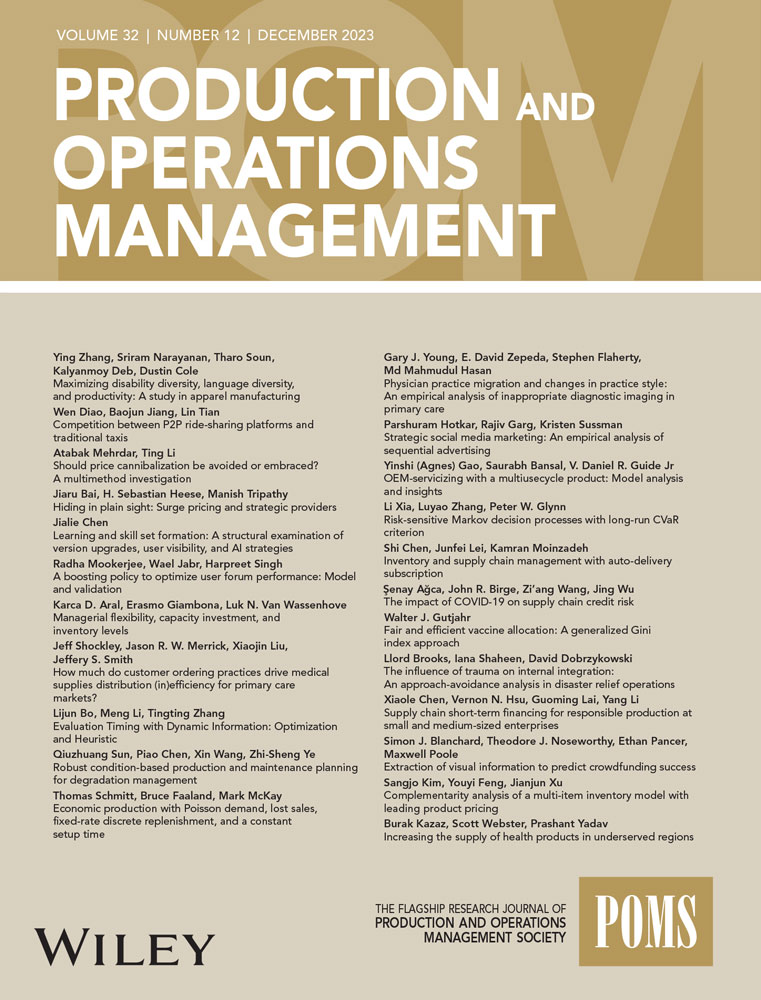混合自主模式下通过战略通信实现的智能导航
IF 5.1
3区 管理学
Q1 ENGINEERING, MANUFACTURING
引用次数: 0
摘要
摘要:受协作机器人拣货操作中出现的混合自主模式的启发,我们研究了在内部物流系统中导航人类工人(HWs)与自主移动机器人(AMRs)合作的最佳信息设计。我们在路由博弈中引入了amr和hw之间的非对称信息,其中连接的amr被告知拥塞状态,而hw依赖于系统提供的信息。系统设计了一个通信策略,旨在引导硬件设备远离拥塞。如果没有战略通信,我们表明除非自动化水平达到阈值,否则amr的部署不能缓解拥塞。有趣的是,我们说明了当信息失真轻微时,自动化和战略沟通之间存在替代效应。相反,由于拥塞加剧,严重的信息失真与自动化相辅相成。此外,内部AMR车队在经济上比第三方物流服务更高效。因此,内部自动化可以通过轻微的信息失真来实现,而严重的信息失真则需要弥补第三方AMR车队的效率不足。通过模拟的数值例子来补充分析结果,我们提供了关于不同自动化水平下最优信息策略的管理见解,指导仓库管理人员与工人的沟通,以实现机器人系统的最佳性能。本文章由计算机程序翻译,如有差异,请以英文原文为准。
Smart navigation via strategic communications in a mixed autonomous paradigm
Abstract Motivated by the emerging mixed autonomous paradigm in cobotic order picking operations, we investigate the optimal information design to navigate human workers (HWs) who cooperate with autonomous mobile robots (AMRs) within an intralogistics system. We incorporate asymmetric information between AMRs and HWs in a routing game where connected AMRs are informed of the congestion state while HWs rely on information provided by the system. The system designs a communication policy aiming to navigate HWs away from congestion. Without strategic communications, we show that the deployment of AMRs cannot mitigate congestion unless the automation level reaches a threshold. Interestingly, we illustrate a substitution effect between automation and strategic communications when information distortion is mild. In contrast, severe information distortion complements automation due to exacerbated congestion. Furthermore, an in‐house AMR fleet is economically more efficient than a third‐party logistics service. Consequently, in‐house automation can be achieved with mild information distortion, while severe information distortion is required to complement the lack of efficiency in the third‐party AMR fleet. With simulated numerical examples to complement the analytical results, we provide managerial insights concerning the optimal information policies under different levels of automation, guiding warehouse managers in their communications with workers to achieve the best performance of the cobotic system.
求助全文
通过发布文献求助,成功后即可免费获取论文全文。
去求助
来源期刊

Production and Operations Management
管理科学-工程:制造
CiteScore
7.50
自引率
16.00%
发文量
278
审稿时长
24 months
期刊介绍:
The mission of Production and Operations Management is to serve as the flagship research journal in operations management in manufacturing and services. The journal publishes scientific research into the problems, interest, and concerns of managers who manage product and process design, operations, and supply chains. It covers all topics in product and process design, operations, and supply chain management and welcomes papers using any research paradigm.
 求助内容:
求助内容: 应助结果提醒方式:
应助结果提醒方式:


